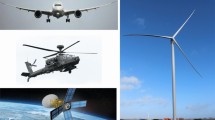Abstract
Throughout the past decades a considerable amount of work has been dedicated to the development and application of formalisms to simulate flexible bodies in a multibody system (MBS). The two most common approaches to describe the deformation of a flexible body with respect to their floating frame of reference are to apply the linear finite-element formulation and the linearmodal approach using global mode shapes.On the field of flexible body modelling, this paper discusses two topics: (a) the consideration of quadratic terms in the equations of deformation and (b) the presentation of methods for global mode preparation to reduce the computer time for dynamic simulations without loss of accuracy regarding deformations.The proposed methods are applied in two examples, for the deformation of a stabilisation linkage of a car's front suspension and for the simulation of the deployment of a flexible solar array.
Similar content being viewed by others
References
Dietz, S., Vibration and Fatigue Analysis of Vehicle Systems Using Component Modes, Dissertation, Fortschritt-Berichte VDI, Reihe 12, Nr. 401, VDI-Verlag, Düsseldorf, 1999.
von Dombrowski, S., ‘Analysis of large flexible body deformation in multibody systems using absolute coordinates’, Multibody System Dynamics 8, 2002, 409–432.
Pösl, C., ‘Erweiterung und Testen des Moduls SimBeam uner SIMPACK’, Diplom Thesis, Fachhochschule München, 2002.
Rulka, W. and Eichberger, A., ‘SIMPACK: An analysis and design tool for mechanical systems’, in Multibody Computer Codes in Vehicle System Dynamics, W. Kortüm and R. S. Sharp (eds.), Vol. 22, Supplement to Vehicle System Dynamics, Swets and Zeitlinger, Amsterdam, 1993, pp. 122–126.
Schwertassek, R. and Wallrapp, O., Dynamik flexibler Mehrkörpersysteme, Vieweg Verlag, Braunschweig, 1999.
Schwertassek, R., Wallrapp, O., and von Dombrowski, S., ‘Modal representation of stress in flexible multibody simulation’, Nonlinear Dynamics 20(4), 1999, 381–399.
Schwertassek, R., Wallrapp, O., and Shabana, A., ‘Flexible multibody simulation and choice of shape functions’, Nonlinear Dynamics 20(4), 1999, 361–380.
Shabana, A. A., ‘Flexible multibody dynamics: Review of past and recent developments’, Multibody System Dynamics 1, 1997, 189–222.
Wallrapp, O., ‘Standardization of flexible body modeling in multibody system codes, Part I: Definition of standard input data’, Mechanics of Structures and Machines 22(3), 1994, 283–304.
Wallrapp, O., Nonlinear Beam Theory in Flexible Multibody Dynamics – Theory of SIMBEAM, Intec GmbH, Wessling, Report, March 2002.
Wallrapp, O. and Schwertassek, R., ‘Representation of geometric stiffening in multibody system simulation’, International Journal for Numerical Methods in Engineering 32, 1991, 1833–1850.
Wallrapp, O. and Wiedemann, S., ‘Simulation of deployment of a flexible solar array’, Multibody System Dynamics 7, 2002, 101–125.
Author information
Authors and Affiliations
Rights and permissions
About this article
Cite this article
Wallrapp, O., Wiedemann, S. Comparison of Results in Flexible Multibody Dynamics Using Various Approaches. Nonlinear Dynamics 34, 189–206 (2003). https://doi.org/10.1023/B:NODY.0000014559.74006.fb
Issue Date:
DOI: https://doi.org/10.1023/B:NODY.0000014559.74006.fb




